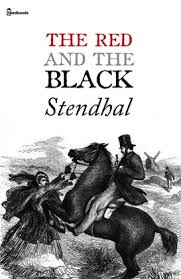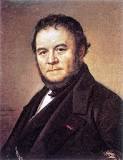The Red and the Black Page #2
Le Rouge et le Noir is a historical psychological novel in two volumes by Stendhal, published in 1830. It chronicles the attempts of a provincial young man to rise socially beyond his modest upbringing through a combination of talent, hard work, deception, and hypocrisy.
Genre: History, Novel
Genre: History, Novel
- Year:
- 1830
- 1,090 Views
Disgusted by the Restoration, Stendhal migrated in 1814 to Milan, his favourite town in Europe, whose rich and varied life he savoured to the full from the celebrated ices in the entreates of the opera, to the reciprocated interest of Mme. Angelina Pietragrua (the Duchesse de Sansererina of the Chartreuse of Parma), "a sublime wanton à la Lucrezia Borgia" who would appear to have deceived him systematically. It was in Milan that Stendhal first began to write for publication, producing in 1814 The Lives of Haydn and Mozart, and in 1817 a series of travel sketches, Rome, Naples, Florence, which was published in London. It was in Milan also than Stendhal first nursed the abstract thrills of his grand passion for Métilde Countess Dunbowska, whose angelic sweetness would seem to have served at any rate to some extent as a prototype to the character of Mme. de Rênal. In 1821 the novelist was expelled from Milan on the apparently unfounded accusation of being a French spy. It is typical of that mixture of brutal sensuality and rarefied sentimentalism which is one of the most fascinating features of Stendhal's character, that even though he had never loved more than the lady's heart, he should have remained for three years faithful to this mistress of his ideal. In 1822 Stendhal published his treatise, De l'Amour, a practical scientific treatise on the erotic emotion by an author who possessed the unusual advantage of being at the same time an acute psychologist and a brilliant man of the world, who could test abstract theories by concrete practice and could co-ordinate what he had felt in himself and observe in others into broad general principles. In 1825 Stendhal plunging vigorously into the controversy between the Classicists and the Romanticists, published his celebrated pamphlet, Racine and Shakespeare, in which he vindicated with successful crispness the claims of live verse against stereotyped couplets and of modern analysis against historical tradition. His next work was the Life of Rossini, whom he had known personally in Milan, while in 1827 he published his first novel Armance, which, while not equal to the author's greatest work, give none the less good promise of that analytical dash which he was subsequently to manifest. After Armance come the well-known Promenades Rome, while the Stendhalian masterpiece Le Rouge et Le Noir was presented in 1830 to an unappreciative public. Enthusiasm for this book is the infallible test of your true Stendhalian. Some critics may prefer, possibly, the more Jamesian delicacy of Armance, and others fortified by the example of Goethe may avow their predilection for The Chartreuse de Parme with all the jeune premier charm of its amiable hero. But in our view no book by Stendhal is capable of giving the reader such intellectual thrills as that work which has been adjudged to be his greatest by Balzac, by Taine, by Bourget. Certainly no other book by Stendhal than that which has conjured up Rougistes in all countries in Europe has been the object of a cult in itself. We doubt, moreover, if there is any other modern book whether by Stendhal or any one else, which has actually been learnt by heart by its devotees, who, if we may borrow the story told by M. Paul Bourget, are accustomed to challenge the authenticity of each other's knowledge by starting off with some random passage only to find it immediately taken up, as though the book had been the very Bible itself.
Translation
Translate and read this book in other languages:
Select another language:
- - Select -
- 简体中文 (Chinese - Simplified)
- 繁體中文 (Chinese - Traditional)
- Español (Spanish)
- Esperanto (Esperanto)
- 日本語 (Japanese)
- Português (Portuguese)
- Deutsch (German)
- العربية (Arabic)
- Français (French)
- Русский (Russian)
- ಕನ್ನಡ (Kannada)
- 한국어 (Korean)
- עברית (Hebrew)
- Gaeilge (Irish)
- Українська (Ukrainian)
- اردو (Urdu)
- Magyar (Hungarian)
- मानक हिन्दी (Hindi)
- Indonesia (Indonesian)
- Italiano (Italian)
- தமிழ் (Tamil)
- Türkçe (Turkish)
- తెలుగు (Telugu)
- ภาษาไทย (Thai)
- Tiếng Việt (Vietnamese)
- Čeština (Czech)
- Polski (Polish)
- Bahasa Indonesia (Indonesian)
- Românește (Romanian)
- Nederlands (Dutch)
- Ελληνικά (Greek)
- Latinum (Latin)
- Svenska (Swedish)
- Dansk (Danish)
- Suomi (Finnish)
- فارسی (Persian)
- ייִדיש (Yiddish)
- հայերեն (Armenian)
- Norsk (Norwegian)
- English (English)
Citation
Use the citation below to add this book to your bibliography:
Style:MLAChicagoAPA
"The Red and the Black Books." Literature.com. STANDS4 LLC, 2024. Web. 23 Apr. 2024. <https://www.literature.com/book/the_red_and_the_black_201>.




Discuss this The Red and the Black book with the community:
Report Comment
We're doing our best to make sure our content is useful, accurate and safe.
If by any chance you spot an inappropriate comment while navigating through our website please use this form to let us know, and we'll take care of it shortly.
Attachment
You need to be logged in to favorite.
Log In